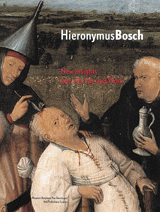
Laemers 2001
“Hieronymus Bosch and the Tradition of the Early Netherlandish Triptych” (Suzanne Laemers) 2001
[in: Jos Koldeweij, Bernard Vermet and Barbera van Kooij (eds.), Hieronymus Bosch. New Insights Into His Life and Work. Museum Boijmans Van Beuningen-NAi Publishers-Ludion, Rotterdam, 2001, pp. 76-85]
It may be assumed that Bosch, like his predecessors and contemporaries, painted his triptychs on commission for the embellishment of church altars. Just how much Bosch’s triptychs fit the pattern of the early Netherlandish triptych becomes apparent on comparing them with the triptychs of his predecessors and contemporaries. For her master’s thesis (Radboud University Nijmegen, 1995) Laemers studied 156 Southern Netherlandish triptychs dating from 1390 to 1520.
Although the combination of the Man of Sorrows and the Passion cycle on the exterior of the Adoration of the Magi (Madrid) may be termed unique, the iconographical programme as a whole is entirely in keeping with the tradition of the early Netherlandish triptych: following the heraldic tradition the male donor is shown, as was customary, to the right of the main scene, thus being more important than the female donor who is shown on the left. Unlike the Adoration of the Magi theme, the Saint Gregory Mass was seldom portrayed in early Netherlandish triptychs. There can be no doubt that this triptych was originally an altarpiece in a church.
The theme of the central panel of the Last Judgment (Vienna) departs in no way from tradition. Remarkable though are some aspects of the representation: to the scenes of hell (central and right panel) is devoted more attention than usually and the Last Judgment is preceded by scenes from the lives of Adam and Eve. The saints on the exterior probably refer to the donors or to the church or chapel for which the triptych (as an altar piece) was intended.
On the Temptations of St. Anthony (Lisbon) the combination of the Passion scenes on the exterior with scenes about St. Anthony (the crucifix on the central panel refers to the exterior and vice versa) may be termed unique, compared to other surviving triptychs. The religious nature of the triptych indicates that it will originally have adorned a church altar.
On the Crucified Martyr (Venice) the donors have been overpainted, but this is a phenomenon that also occurs in the works of Bosch’s predecessors and contemporaries. The martyrdom of a saint was not infrequently chosen as the main subject of a triptych. Representations of various saints, as on the Hermits triptych (Venice) are also found on other Netherlandish triptychs. Both these triptychs were probably altar pieces, given their similarity to other early Netherlandish triptychs.
The themes of the interior and exterior of the Haywain (Madrid) are unique. Though it may be difficult to imagine that it ever embellished an altar, especially in view of its mockery of the avaricious prelates, the unmistakable religious tenor of the triptych makes it a possibility that cannot be ruled out. From the fact that the Garden of Delights (Madrid) was in the palace of Henry III of Nassau one year after Bosch’s death it may be inferred that it has never adorned an altar. But this does not diminish the religious meaning of the picture: as evidenced by contemporary paintings and fifteenth-century book illustrations triptychs were also used by individuals for their private devotions.
Laemers concludes that Bosch’s triptychs are deeply anchored in the tradition of the early Netherlandish triptych, notwithstanding the remarkable choice and elaboration of the themes. Bosch’s triptychs, like those of his predecessors and contemporaries, attest to church doctrine and link the exterior and interior panels in a functional way.
It may be questioned whether the fact that the Garden of Delights was in a palace in 1517 indeed proves that this triptych has never adorned an altar. It is possible that the triptych adorned an altar in the palace’s chapel. For the time being nothing conclusive can be said about this matter.
[explicit]